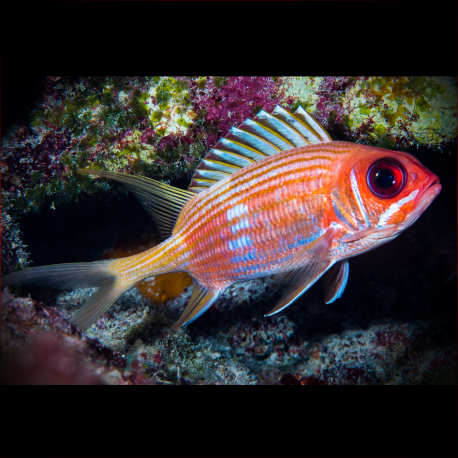More info
Datasheet
| Minimum Tank Size | 800 litres / 211.34 US gallons |
| Maximum Size | 35.0cm / 13.78inches |
| Reef Compatible | Reef safe with caution |
| Temperament | Peaceful |
| Temperature | 22.2°C / 71.96°F - 25.6°C / 78.08°F |
| Specific Gravity | 1.020-1.025 |
| Carbonate Hardness | 8-12 |
| pH | 8.1-8.4 |
General Description:The Longspine squirrelfish, scientifically known as Holocentrus rufus, belongs to the Holocentridae family. This species can be identified by the distinctive white triangles located at the tips of its dorsal fin. They are typically found in the Western Atlantic, ranging from Bermuda and southern Florida to northern South America and Brazil, including the West Indies and areas from the Antilles to Colombia.
Aquarium Suitability:The Longspine squirrelfish is deemed suitable for aquariums with caution due to its potential threat towards small fish and crustaceans. They thrive best in dimly lit environments and prefer to have overhangs and caves within their tank. These fish are nocturnal, typically staying hidden among rocks, and may be aggressive if not given enough space.
Demands:These squirrelfish are considered hardy and have a peaceful temperament when provided with adequate space. They can be housed singularly or in groups within a tank with appropriate hiding spots and minimal stressors.
Care and Hardiness:Given their hardiness, Longspine squirrelfish require a tank of at least 800 liters. Water conditions should include a temperature range of 22.2-25.6°C, pH levels between 8.1-8.4, a specific gravity of 1.020-1.025, and a carbonate hardness of 8-12 dKH.
Reef Suitability:This species is deemed reef-safe with caution, as they may pose a threat to small crustaceans in a reef environment.
Aquarium Setup:Creating an environment with dim lighting, overhangs, and caves is essential for successfully keeping Longspine squirrelfish. Care should be taken not to use fishnets when handling these fish, as their spiky head and gills can easily get caught and lead to injury.
Behaviour:Longspine squirrelfish are known to be secretive, preferring to hide among rocks, and are most active during nighttime. While they are not generally aggressive, they might display territorial behavior if space is limited.
Feeding and Diet:Their recommended diet includes larger crustaceans, other invertebrates, and small crustaceans like krill, mysis, and artemia. Feeding these fish is best done during the night or with dimmed lighting, and live food may be necessary initially to entice them to eat.
Habitat and Distribution:In their natural habitat, Longspine squirrelfish are found in the Mexican Gulf and throughout the Western Atlantic region. Their distribution spans from Bermuda and southern Florida to northern South America and Brazil, encompassing the Antilles and areas from the northwestern Gulf of Mexico to Colombia.

